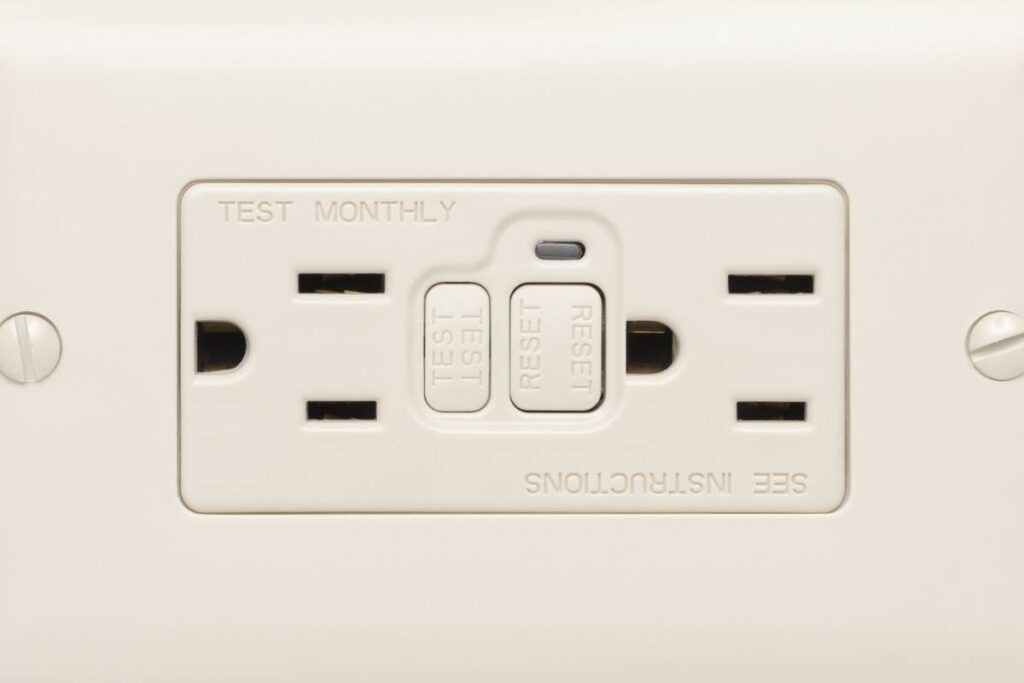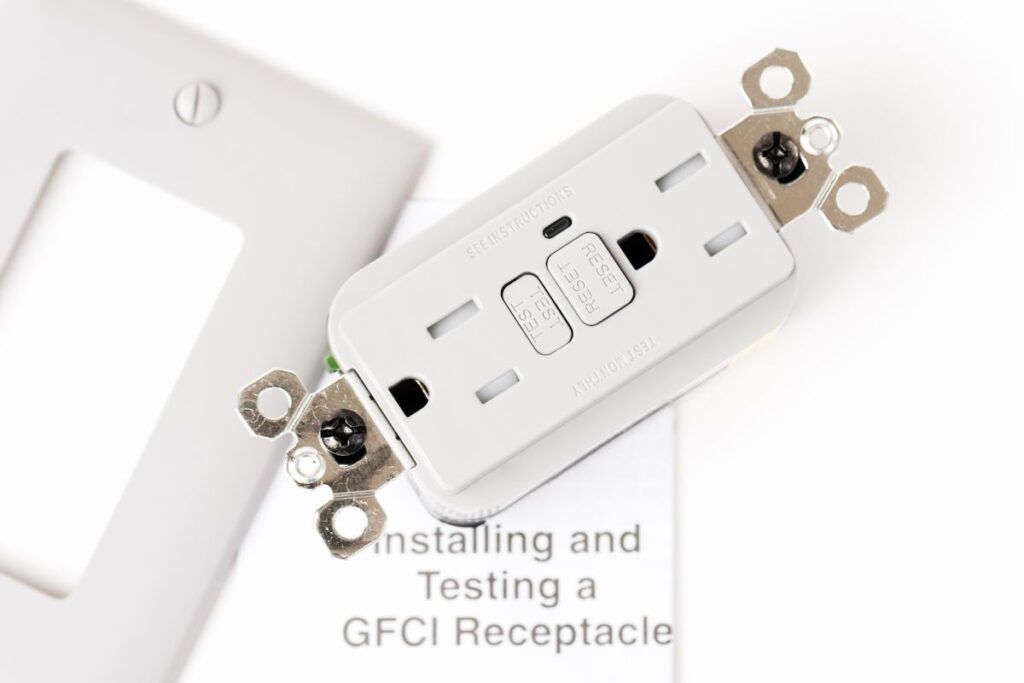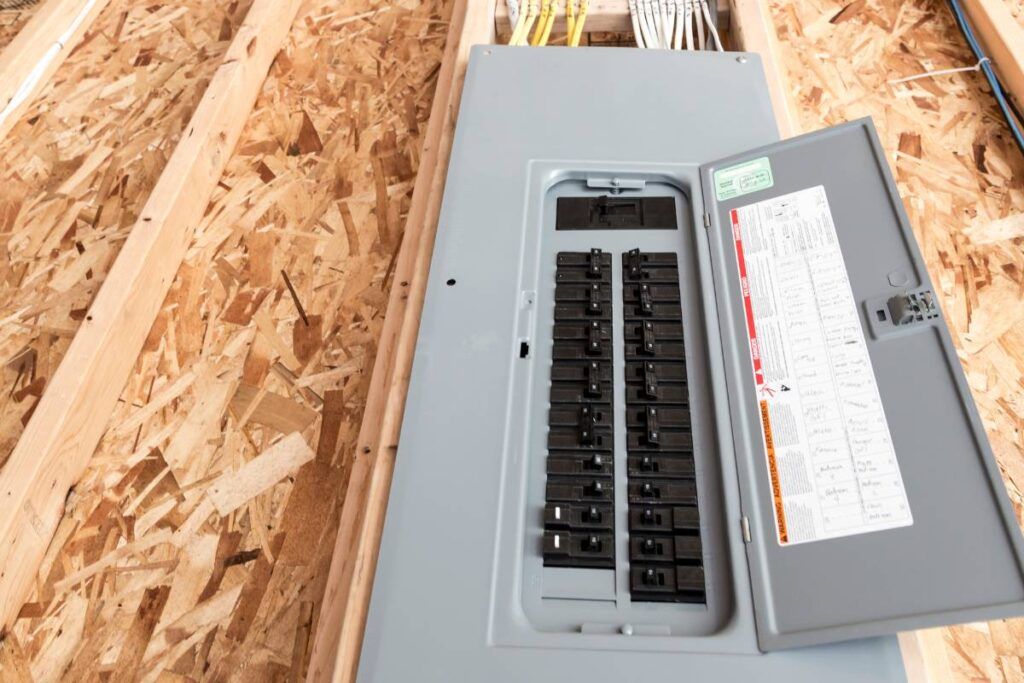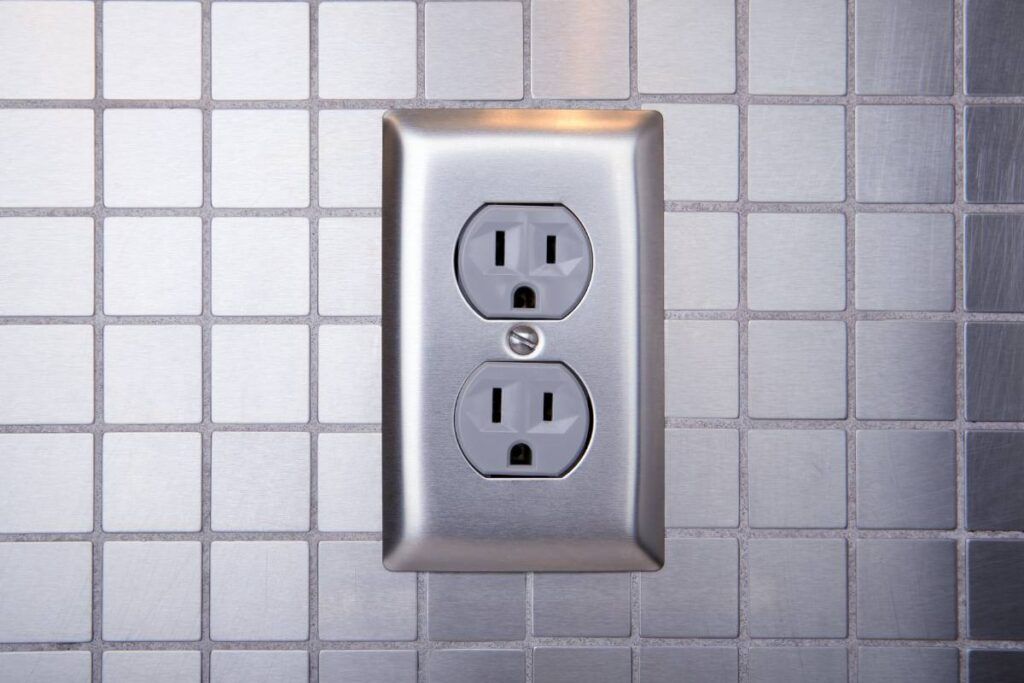GFCIs, or Ground Fault Circuit Interrupters, are common in most houses. They can protect the circuit by tripping whenever it detects danger. But how many outlets can GFCI protect? That’s what we will share today.
Usually, there is no limit to how many outlets a GFCI can protect. The number of outlets you can connect to a GFCI breaker or one GFCI outlet depends on the circuit’s load capacity. For example, in a 15-amp breaker, be it GFCI or standard, you can connect 8-10 outlets.
If you are in doubt, this is the right place to clear your confusion as we will share everything related to GFCI – its purpose, the number of outlets to connect with it, the code requirements, best practices, common misconceptions, and troubleshooting tips.

Check out our list of top-handpicked products for all your electrical, appliance, and HVAC system needs to keep your home running smoothly.
This post includes some affiliate links.Understanding the purpose of GFCI and how it works
The term GFCI stands for Ground Fault Circuit Interrupter.
It is a breaker sensitive to leakage and ground faults. It has an in-built sensor that can detect the ground fault.
As soon as it detects the fault, it will trip to turn off the power and save you from electrical shocks.
Besides, it will also protect the appliance connected to the outlet from damage.
The GFCIs are used in moisture-prone areas like kitchens, bathrooms, laundry, garages, wet bars, spa rooms, and pool areas.
These are common areas where water can enter the outlet, current leaks, and ground faults can occur.
There are three types of GFCI – outlet, breaker, and portable GFCI.
GFCI outlet
The GFCI outlet is like a standard outlet with GFCI protection.
You can plug an appliance into it and use it.
When there is a ground fault, the outlet will trip, turn off the appliance, and save it from getting damaged.
You can also connect the outlet with other outlets to save them similarly.
GFCI breaker
The breaker is like a standard circuit breaker with GFCI protection.
It protects the entire circuit and every other standard outlet connected to it.
Instead of connecting one GFCI outlet to several other standard outlets, you can install one breaker and connect the outlets of the moisture-prone areas to it.
However, ensure that the breaker matches the requirements of the main panel.
For older panels that use fuse boxes, you must use outlets, not breakers.
Portable GFCIs
Contractors use these on the worksites. But you can also use it for any electrically-powered appliance needing GFCI protection.
Please do not use it instead of the permanent outlets all the time.
Only use it when you have to bring power from an unprotected outlet to a dangerous situation.
Types of electrical circuits that require GFCI protection
The GFCI protection is ideal for all electrical circuits and outlets to prevent electrical shocks and fire hazards.
Since they are costly, you cannot use them for all the circuits.
You especially need GFCI protection for circuits powering the appliances in damp locations.
The NEC, or National Electric Code, has explained the specific requirements of GFCI protection in certain areas, like:
- Bathroom
- Kitchen
- Garage
- Outdoor
- Underwater pool lighting
- Crawl spaces
- Wet bar sinks
- Unfinished basements
- Laundry
- Utility sinks
The number of outlets that can be connected to the GFCI

GFCI helps protect people from electrical shocks when there is a ground fault by shutting down the power source.
So, you can rely on them for multiple outlets, especially those in water-prone areas. But how many outlets will that be?
If you properly install the GFCI device in your circuit, it can protect up to 20 amp circuits and a maximum of 10 to 12 outlets. But there is no confirmation about it.
When you connect two or more GFCI outlets in the same circuit, there is no limit to the number of outlets it can protect.
However, the combined rate should not exceed the circuit’s amperage rating.
The NEC has left this decision in the hands of the house owners.
NEC does not mention the number of outlets to be protected by a GFCI. It strictly depends on the ampacity of the breaker.
As a rule of thumb, an individual circuit has a rated load.
It must carry at least 80% of the load among that rated load.
For example, if you have a 20-amp GFCI breaker, only 16 amps load should be used, and the remaining 4 amps should remain empty.
Each outlet will draw at least 1.5 amps. So, you can upload 10 outlets in a 20-amp circuit.
Can one GFCI outlet protect the entire circuit?
It is one of the most common questions asked because the GFCIs are costlier than the standard outlets.
If you have bought only one GFCI receptacle, it is meant to connect to a single outlet and protect the same.
If you follow this process, the cost is the problem in such a setting.
Instead of that, install one GFCI to protect all the outlets in the same circuit and protect it.
Place the receptacle at the first outlet of the circuit.
It will protect every outlet downstream in the same circuit.
The GFCI receptacles will have LINE and LOAD terminals.
If you connect all the outlets to one GFCI’s LOAD, the outlets will receive the protection of GFCI.
However, there is a problem. GFCIs are known for nuisance tripping.
If the GFCI receptacle upstream trips, all the downstream outlets connected to the GFCI will trip.
Thus, some prefer GFCI receptacles for single outlets to prevent nuisance tripping.
A GFCI will react to current leakage by tripping.
If multiple devices are downstream, the cumulative effect of the current leak from all the outlets will cause nuisance tripping.
As a result, you will spend several hours plugging and unplugging the appliances, locating devices responsible for tripping, and testing and resetting the breaker.
The maximum load capacity of the GFCI
The maximum load capacity of the GFCI is mentioned in the breaker or the outlet.
Usually, maximum GFCIs are rated for 15 amps or 20 amps at 120 volts, alternating current.
Whenever you connect outlets to a circuit breaker, note that the load you put over the circuit should not exceed the circuit’s rated load.
Additionally, use appliances that can draw enough power from the outlet without tripping.
The breaker load rule is 1.5 amps per outlet.
So, if you have a 20 amp breaker, the used load should be within 16 amps and not exceed 20 amps. For 15 amps, it is 12 amps.
The outlet will trip if you connect an appliance to a 15-amp breaker that draws power draw more than 12 amps.
Additionally, if the appliance alone uses 12 amps, you cannot run other appliances together.
Factors affecting the number of outlets a GFCI can protect

The number of outlets a GFCI can protect depends on several factors, like the circuit ampacity, the voltage, wire configuration, and appliance load.
Circuit amperage
The number of outlets to add in a GFCI depends on the breaker’s rated load.
The GFCI breaker works as a standard circuit breaker with extra protection.
So, the method of adding outlets is the same for both.
In most situations, 15 amps and 20 amps GFCI breakers are used.
These two ratings are enough to power the appliances in the bathrooms, kitchen, or near water source areas.
A 15 amp GFCI breaker can protect around 8 to 10 outlets, and a 20 amp breaker will protect 10 to 12 outlets.
But, due to the increased technology recently, the NEC has extended the ampacity.
According to NEC 2020 Article 210.8 (F), GFCI breakers have extended protection to the circuits that feed heavy-duty appliances like washers and HVAC units.
If you want high-rated outlets, buy from Siemens.
They have included GFCI breakers measuring 25, 35, and 45 amps.
With these circuit breakers, you can increase the number of outlets in your GFCI circuit according to the rated load.
Voltage
The voltage is another important factor.
Higher voltage allows you to add more outlets than the standard number.
Since the voltage will be high, it can handle the outlets and the load the appliance draws from the circuit breaker.
Here is a small calculation of the circuit volts and the number of outlets they can handle:
- 15 amps 120V – 8 outlets
- 15 amps 240V – 16 outlets
- 20 amps 120V – 10 outlets
- 20 amps 240V – 20 outlets
Consult an electrician before deciding on the number of outlets to add.
Wire configuration
The wire configuration of the GFCI circuit breaker will also determine the number of outlets to be added to the breaker.
Installing a GFCI outlet at the beginning of the circuit can protect the remaining downstream outlets.
For example, if the circuit holds 20 outlets, the one GFCI outlet wired at the beginning of the circuit will protect the remaining 19 outlets.
However, the number of outlets in the circuit should not exceed the circuit load.
Appliance load
A GFCI breaker cannot protect all the outlets due to the power drawn by some heavy appliances.
So, these heavy-duty appliances will need a dedicated circuit breaker for safety.
You can add outlets to the circuit breaker and use them. But, it will cause nuisance tripping due to overloading.
So, this reduces the number of outlets to be protected by the GFCI.
So, if you have such a dedicated breaker for a heavy-duty appliance, only one outlet used to run the appliance will be protected.
Best practices for installing multiple GFCI outlets to a circuit

Installing GFCIs in the circuit requires proper planning for safety execution.
So, here are some best practices to follow while installing a GFCI to the circuit:
- Before installing the outlets, ensure the circuit can handle the load. However, adding a few more will be okay only if you do not use all the outlets simultaneously.
- The outlets have various configurations and styles. Choose a suitable one that can adequately indicate a ground fault and ease out the TEST and RESET processes. Additionally, keep the location into account. For outdoor areas, choose weather-resistant GFCIs.
- If you plan to install only one GFCI at the beginning of the circuit to protect other outlets downstream, wire the first one correctly. Connect the LINE and LOAD terminals with the correct screws.
- Label the outlets with GFCI protection to identify the outlets during tripping.
- After the installation, test the outlets properly to ensure nothing has gone wrong. In case anything is wrong, recheck and rewire the outlet again.
- Follow the electrical codes before you install the GFCIs. Otherwise, you will end up with reinstallation and penalties.
Code requirements for GFCI protection in residential and commercial buildings
Before you use GFCIs, you must ensure that the code requirements for GFCIs in the NEC or local codes are met.
Otherwise, you have to repeat these installations correctly and pay penalty charges.
The NEC has extended the GFCI requirements since 1971 so that everyone gets protected whenever they plug any appliance into an electrical system.
Previously, it was specifically for the temporary wiring constructions in water-prone areas, like bathrooms.
But now, it has been extended to several other locations, like commercial occupancies, fountains, pool areas, kitchens, laundry, garages, outdoors, etc.
This section talks about the GFCI code requirements for both commercial and dwelling units:
Commercial buildings
According to NEC 210.8, GFCI protection is crucial for all the 15 and 20 amps 125V receptacles in the commercial facilities’ bathrooms, rooftops, and kitchens.
The GFCI protection is not required for receptacles outside commercial buildings.
The NEC 210.63 also claims to install 15 or 20-amp, 125V receptacles within 25 feet of the commercial buildings’ heaters, AC, and refrigerators.
According to NEC 426.28, you need a dedicated branch circuit for electric snow melters or de-icing appliances.
Every receptacle outlet in the kitchen must have GFCI protection.
According to NEC 210.8 (A) (6), only the 15 and 20-amp outlets of residential kitchens were provided GFCI protection.
But, according to NEC 210.8 (B), all 15 and 20-amp outlets of both commercial and residential kitchens will be provided with GFCI protection.
Residential buildings
As explained above, GFCI protection was available only for 15 and 20 amps circuits in the bathroom.
It is for residential buildings.
But now, according to NEC 210.8 (A) (2), GFCI protection is also given to all the 15 and 20-amp circuits in the garages, kitchens, unfinished basements, and near any water source.
There are a few exceptions, though, for example:
- Inaccessible receptacles like the ceiling-mounted outlet in the garage door opener
- An outlet for a dedicated branch circuit for a cord-and-plug appliance, like fridges and freezers.
According to NEC 210.8 (A) (3), all the 15 and 20 amps 125V outlets outside the dwelling unit should be GFCI-protected, especially those under the rooftop eaves.
The exception is that the de-icing equipment is not accessible and should have a dedicated branch circuit.
Benefits of using GFCI protection in electrical circuits

GFCIs can provide us with multiple benefits:
- Since the GFCI will monitor the current flow and trip the breaker whenever there is a ground fault, it will prevent the dangerous electric shock and save us from it.
- Leaks in the current flow can cause sparks and fire hazards. GFCI will detect the leakage, trip the GFCI, and stop the sparks and fire from happening.
- When these accidents happen, there is a high chance that the connected appliance can damage. Tripping shuts off the current flow, thus saving the appliances from getting damaged.
- The GFCI contains an in-built mechanism that constantly monitors the current flow in the circuit or outlet. The in-built sensor can sense the ground faults and trips off to shut down the power flow and prevent the ground fault from causing accidents.
- GFCIs can immediately identify the problems and warn you with their light indicators. Additionally, it contains a TEST and RESET button that allows you to restore the power without the help of an electrician.
Difference between GFCI outlets and GFCI breakers
Both work the same as they monitor the current flow and trip off whenever it detects a ground fault.
Circuit breakers are like standard breakers with GFCI protection.
They shut off the electric power whenever they sense a ground fault.
The breaker monitors the current flowing through the connecting equipment and the circuit.
With breakers, you can protect every outlet connected to the circuit.
On the contrary, the GFCI outlets protect only the outlet.
The outlets also monitor the current flow and trip off whenever it detects a ground fault.
However, instead of getting installed in the main breaker, like the branch circuit, it is installed in the individual outlets.
During a sudden current drop, especially when the connected appliance touches moisture, it will shut off the power and save you from electrical shocks and sparks.
With a GFCI outlet, only the particular items connected to the outlet are protected.
The main difference is in their installation.
The breakers are connected to the main panel, whereas the receptacles are installed to the individual outlets.
Another difference is in reset. In an outlet, you can reset locally with a TEST or RESET button.
But, in the breaker, you have to travel to the breaker box for resetting.
Troubleshooting common issues with GFCI outlets
Even with in-build protection mechanisms, GFCIs are subject to various issues due to wrong wiring and faulty or dead outlets.
Here are some troubleshooting tips for common issues with GFCI outlets:
- Whenever your GFCI doesn’t work well, try resetting the outlet. Press the RESET button until it clicks and locks in place, and then test the outlet. If the outlet is still dead, you have other issues.
- Upstream is the point towards the power source. There might be a problem upstream. Check the breaker, push it OFF and then ON position, or press the TEST and RESET buttons in the outlet. If the power still doesn’t come back, try other things.
- Sometimes, the power does not return after a reset because you test the outlet with a switched-off light switch. Turn on the light and then test your outlet. Your power will come back.
- If the power doesn’t come back, you have a faulty outlet or defective reset mechanism. When you press the TEST button, you hear a crunchy sound that suggests you have a damaged mechanism.
- Wiring issues are another issue, such as loose wires or wires connected to the wrong terminals. Turn off the power, open the outlet, and check the wire connections. If the wires are loose, tighten them. If they are connected to the wrong terminals, connect them to the right one. Here, you may need an expert’s help.
- Sometimes, it is just the appliance and not the outlet. Connect the appliance to other outlets or other devices to this outlet, and you will get the answer.
How to test and maintain GFCI protection in your electrical system?
A GFCI protects you from short circuits, but the number of outlets a single GFCI can protect depends on the breaker rating.
You should once consult your electrician to confirm how many outlets you can protect.
Once you have done the installation and wiring to protect the outlets, you should test the GFCI and maintain it to ensure prolonged protection.
- Here are some steps to test and maintain GFCI protection:
- After the installation is complete, press the TEST button. If the RESET button pops out, your GFCI is working correctly.
- Plug a device into the GFCI outlet. It should turn off when you press the TEST button.
- Press the RESET button to restart the GFCI and bring back power.
- To maintain the GFCI, take good care of it and avoid overloading the circuit or outlet.
- Test your GFCI once a month to ensure its condition.
- Suppose your GFCI doesn’t pop out the RESET button after pressing the TEST button, or the device connected doesn’t turn off. In that case, you have a defective GFCI which needs replacement.
- If your GFCI trips frequently, you have probably overloaded the circuit, or there is some fault in the electrical system or connected devices. Consult an electrician to fix the problem.
Electrical safety tips for using outlets in a GFCI protected circuits

Generally, outlet wiring is always done by an expert because they have better ideas about the wires. While wiring GFCIs to the outlets, you should be careful about a few things.
Here are some safety tips for you while using outlets in GFCI breakers:
- Always turn off the power at the main panel to stop the current flow while working.
- Use a voltage tester or multimeter to ensure the power has genuinely stopped flowing through the breaker and outlets.
- Before installing the outlets, ensure that the GFCI breaker can handle the number of outlets you add without overloading.
- Use the proper polarity by identifying the LOAD and LINE terminals and connecting the correct wires to the proper terminals.
- Consider regularly checking, testing, and maintaining the GFCI outlets and breakers.
- Wear protective gear like goggles and insulated gloves while working.
- Avoid working around wet areas or with wet hands.
- If you are in doubt, always consult an electrician.
Common misconceptions about GFCI protection and electrical safety
GFCIs protect people from electrocution and the appliance connected to the outlet from getting damaged during a ground fault.
A ground fault occurs when the L-N current potential surpasses 3mA to 6mA.
The GFCI can detect the problem and trip the breaker whenever this happens.
But, there are some misconceptions or myths people have about GFCIs:
Misconception 1
The first misconception is that you need a ground wire to install the GFCI, and you cannot use GFCIs in the old 2-wire circuits.
The sensing functions of the GFCIs use only hot and neutral, which is why you do not require the ground.
You can, of course, use GFCIs for the older 2-wire circuits.
Misconception 2
GFCIs are costly. People say that all the GFCIs provide the same protection.
So, it would be best to buy the cheaper one. That is not what you should do.
Instead of looking for cheaper GFCIs, you choose the one with proper features, for example, wiring error indicators, test and reset buttons, tripping indicators, etc.
These indicators will help you know when an error might occur, so you can prepare to reset it.
Misconception 3
The third misconception is that you should put the GFCI in the first bathroom from the circuit breaker.
That is not a fact. You can upgrade the protection by installing GFCI in each bathroom.
Wire them so that each bathroom can feed the next by connecting the load wires to the hot terminals at the bottom until you reach the last GFCI.
Lastly, wire the last GFCI to protect the downstream loads.
Final thoughts
There is no limit to the number of outlets a GFCI can protect. It depends on the breaker’s load capacity, wire configuration, and circuit voltage. The GFCI breaker should adequately handle the number of outlets you add. For example, if you use a 15 amp GFCI circuit, it can protect 8-10 outlets.
If you plan to add only one GFCI and wire the other standard outlets with it for GFCI protection, wire the GFCI at the beginning of the circuit. It will protect every other outlet downstream.
Once you have made the installations, test them to confirm the installation is correct. Maintain the GFCI to receive protection in the long run. Follow the best practices and safety tips to prevent silly mistakes and keep the GFCI safe and secure.
Can I use 15 amp outlets in a 20 amp circuit?
Yes, you can do it because the rated load used by the outlet will be 15 amps, and 20 amps can carry loads of up to 16 amps. A lot of houses have several 15-amp receptacles connected to a 20-amp circuit. But you can only use one outlet for the circuit.
Can you daisy-chain the GFCI outlets?
Yes, you can do it, but it is not recommended because if one outlet trips, the other outlets will also trip. As a result, there will be no GFCI protection in those outlets. That is why it is recommended to wire the GFCI outlets in parallel.
Reference: GFCI outlets
